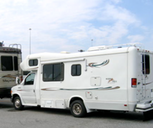July 12
Adding things up took a little time this year because we spent US dollars, Norwegian Kroner, Euros, British Pounds Sterling and Danish Kroner. In the past we have paid cash for virtually everything. This year, though, we had to use our debit card often, especially for campground reservations. We use a dedicated debit card/checking account which charges only a 1% foreign transaction fee. We rarely had to use our credit card, which has a 3% fee. None of the ATMs we used charged a fee until we got on a ferry to Denmark.
We normally plan to have $1000 a week available for all expenses and hope that we won’t really have to spend it. Then we put a little extra in the account for backup in case of emergencies. This year we also planned on three ferry trips, which were unusual expenses. And, of course, everything turned out to be far more expensive than we had hoped! We spent all that and a little more.
Gasoline: $3047 for 363.7 gallons (averaging $8.37/gal). We drove 3373 miles, averaging 43 miles each day; as close as we can figure, Rover got 9.2/mpg. We had only ten days where we traveled more than 100 miles, including one day of 200+ miles.
July 3
We were off the ferry in Denmark within minutes of its docking. We had purchased a good map of the country on board and were able to drive (on the right!) right out of town and on our way. Our first impression of Denmark: flat, And very little traffic for a Friday afternoon. We drove on reasonably wide roads to Billund, the home of Legoland amusement park, and to the campground across the street from it . . . and discovered where all the cars in Denmark were.
We arrived too late to visit Legoland, and the next day it was raining, so we decided that that was something we should do with our granddaughter anyway. We then left for one of our longest drives yet: 172 miles to Frederickshavn. We had traveled about five miles when, almost together, we both said, “A hill!” It really was the first real hill we had encountered since leaving the ship. Traffic, again, was very light until we reached the E, the Danish version of the interstate highway. It was very busy, and we saw many camping trailers and motorhomes going south. We later learned this was the first day of the major “everyone goes on vacation at once” period that is common over most of Europe.
July 1
We have driven safely on the left for 2964 miles in England and Scotland. That proved remarkably easy to get used to, and David got really good at negotiating traffic circles, of which there are thousands. Except for the major multilane motorways, or M’s, the “narrow road” label is really true, particularly in a wide American motorhome. But British drivers are used to it, stopping to let us and others pass through a narrow section, taking turns when necessary, and nearly always staying well on their side of the road.
(One example of British drivers' usual attitude toward the other guy: on the Continent, flashing your headlights at another driver means “I have rights and I mean to exercise them,” e.g., to drive through this narrow section of road ahead of you or to go as fast as I want in the passing lane that you, a slower driver, are improperly occupying. In Britain, though, flashing your lights at another driver means “You may go first through this narrow section” or, as you are attempting to merge with traffic on the M, “Come on into the lane ahead of me; I’ll actually slow down to let you in.” And that attitude is common among truckers as well.)
June 30
We found ourselves with an empty day, so we backtracked toward Cambridge to go to the Duxford Imperial War Museum. This is a huge, impressive place at Duxford Air Field, used by the Royal Air Force and hundreds of American pilots during WWII, especially the Battle of Britain. The museum consists of eight huge airplane hanger-like buildings, two of them fairly new construction, to show off the impressive collection of all kinds of aircraft. One building explained the principles of flight and had a piece of Orville and Wilber Wright’s first airplane. We walked through a preproduction Concorde with its testing equipment still in place. Another building was dedicated to the Battle of Britain, another to US Air Force aircraft, and still another to land warfare, with an emphasis on D-Day. These buildings were strung out along the still operational air field, and we put a few miles on our shoes going from one to another and all the way back again. It was a remarkable place.
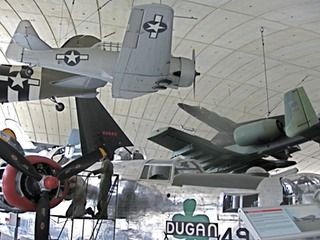
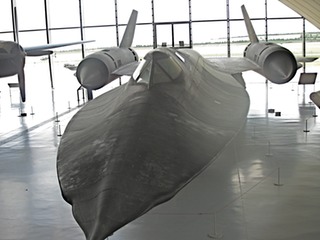
June 28
Our electrical problem has not resolved itself, and we have found no one to help us out with the many suggestions we have received via the internet. But Rover’s engine charges the house batteries while we drive and when we’re in a campground the little battery charger we bought does its thing, so between them we have enough power . . . provided that we run the refrigerator on LP and don’t use the microwave or the oven. (Eating dinner out also helps a lot.) We found that sitting in Cambridge for two nights didn’t drain the batteries either, so we are feeling more confident about finishing the trip by limping along this way.
We made one of our strangest visits yet to an estate called Calke Abbey. It is owned by the National Trust, who made the decision not to restore it to some pristine earlier era but rather to show it to the public just as it was received: in a declining state. The eccentric family that owned it had collected odd things; worse yet, they never threw anything out, but instead, when a room was full of someone’s collection of something or another, merely shut the door and moved on to other rooms. The only restoration that the Trust undertook was to keep the place from deteriorating further. So they fixed the leaking roof, for example, but left the peeling paint on the ceiling and the curling paper on the walls. It was quite an unusual property, out of the way and requiring a one-way mile-long paved drive amid the sheep still grazing on the estate. It was one of our favorites.
June 23
A really good day, but then a turn for the worse. We drove to the small city of Richmond because they have the oldest Georgian theatre in the country and they give tours. We spent a delightful hour in this tiny theatre with a very enthusiastic tour guide. We cannot imagine 400 people, smoking clay pipes, using chamber pots during the evening’s six hours of entertainment, jammed into this fire trap with smelly tallow candles for lighting. But it has survived and been restored to its original glory, except that now it seats maybe 200 at most. The theatre guide recommended we check out the town's little museum: it contains the set for James Herriot’s vet clinic from the tv series “All Creatures Great and Small. There are always surprises everywhere we go.
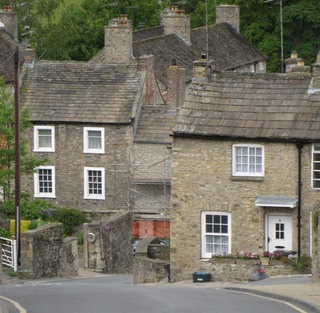
We drove on to a nearby campground and set up for the night. Susan used both the microwave and the oven (not at the same time) with nothing else running, and we thought we had tripped the circuit breaker on the post outside. David tried to fix it, but he and a knowledgeable neighbor couldn’t get the electrics running again. We have battery power for lights, water pump and ignition of the LP for the refrigerator, but we cannot charge the battery with incoming electricity--only from running the engine. It caused us little problem, but great concern.
June 19
We drove from Edinburgh to Berwick-on-Tweed with nary a hedge, stone wall, or too-narrow road along the way. We are now back in England.
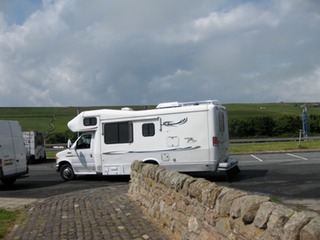
This half in England . . . . This half in Scotland
The Berwick campground was across the Tweed River from the city, high on a hill with great views.
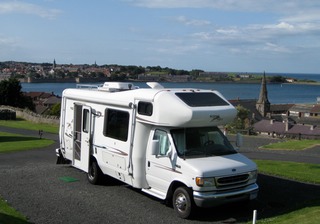
The city, a short bus ride away, was a pleasant surprise. Sited on the border between Scotland and England, Berwick has the distinction of being the most fought over city in the land. It still has much of its fortification wall around the old center and we walked all the way around.
The next day we found Rover’s Mobil 1 oil at an auto supply store and then drove on to Alnwick Castle, the Hogwarts of Harry Potter films.
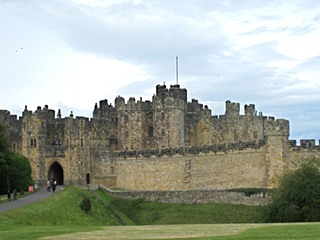
It is occupied by the Duke of Northumberland during the half of the year that it is not open to the public. The castle and estate has been in the Percy family for 800 years. And they are quite a family, with ties to numerous events in British history: the founding of Jamestown, Virginia; being written into a Shakespeare play (Hotspur); an execution ordered by Elizabeth I; a death at Dunkirk in WWII. . . . The rooms open to the public are wonderfully extravagant. The two-story library was worth the admission price alone.
June 15
Just north of Glasgow and Edinburgh, Scotland is only about 35 miles wide. The Highlands begin here, and the only real break in the hills is at Stirling. So, of course, a castle fortification was built there in the 1200s, and for hundreds of years it housed kings when it wasn’t being fought over. The castle is high on a cliff, reached by narrow roads winding right through the city, so we drove Rover to a Park and Ride at the foot of the hill and let the bus driver do the work. Even in the continuous rainfall that day, the castle was a major tourist attraction. Our purchase of the National Trust pass has saved us a great deal of money on entrance fees in England, and we’ve been pleased to find that Scotland accepts it at many sites, too.
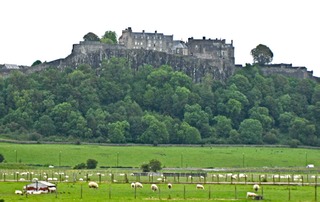
The campground near Stirling, with beautiful views of the hills, not only had a black water dump just for us but also supplied a long hose so we could add water to the toilet tank and rinse it out. We think this is only the second time we’ve been able to do this in all of our trips.
June 10
On our way out of Haltwhistle--the geographical center of Great Britain, they like to say--we stopped at Hadrian’s Wall. This marked the northernmost part of the Roman Empire, as if to say “this is as far as we are going.” The remnants of the wall are about four feet thick and high, and go on for miles and miles. We had to climb up through sheep and cow herds, past some much younger walls, in order to get to the real thing.
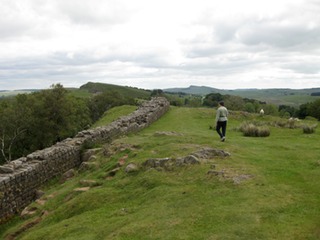
After a quick stop at a lovely little doll house museum we headed north to Moffatt, where we stopped for the night. Right next to the campground was a woolen mill, where we discovered sweaters we hadn’t realized we needed--and on sale, too!
The next day we headed to New Lanark, about 20 miles off the main roads. This mill town was an experiment by Robert Owen, a social reformer intent on improving the lives of his mill workers and educating their children. Along the way, he instituted the first nursery school, initiated an eight-hour work day, banned child labor, and still made a profit for his investors. It is quite a village: some of it is now residences, but much is open to the public. Once again, when we visited the mill’s shop we were compelled to purchase wool sweaters we didn’t know we needed. We expect this pattern will continue.
June 5
Susan writing . . . Caernarfon, Wales (pronounced Car NAH fin). This was a kind of pilgrimage for me: This is where my whole Anglophile thing began. I can remember watching Prince Charles’ investiture at Caernarfon Castle in l969 on our first little black and white 13” television and saying to David, “We need to go to England.” And the next summer, 1970 BC (before children), with a new MA under his belt and two full-time teaching jobs, we took off for 6 weeks--the trip of a lifetime we thought at the time--to England for two weeks and the Continent for four, visiting mainly the big cities. We did not get to Caernarfon.
This time we did. The drive into Wales from Chester was right along Liverpool Bay: long hills, tunnels, slag heaps, tunnels through slag heaps, divided highway almost all the way. It was just that last 100 feet of 20% grade with a 90% turn at the bottom in the campground that slowed us down. “Take the turn wide,” said the lady camp manager. “People keep hittin’ the rocks on the right.” It was a peaceful, green-terraced valley; we ended up driving around back up to the second level, so getting back out wasn’t as bad as getting in.
June 2
This is why we do what we do:
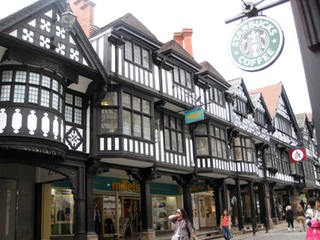
Where else can we sit at a Starbucks and look at Tudor buildings (some of them faux, but who cares)?
Today we visited Chester, a small city in the west-central county of Cheshire. Its medieval center is surrounded by two miles of stone walls: in the southeast corner are ruins of a Roman amphitheater that used to seat 7000; in the northeast there towers an amazing cathedral.
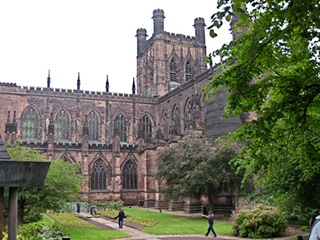
We have seen at least half a dozen ancient cathedrals and abbeys, each big and beautiful in its own way, but this one stopped us in our tracks. We are trying to figure out why: the unusual red sandstone perhaps, or its spacious feeling . . . maybe its integration of modern and medieval features. . . . We aren’t sure.
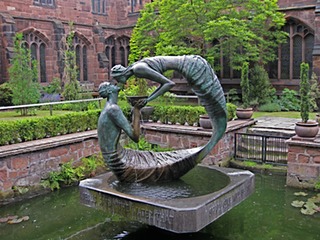
Chester’s inner pedestrian shopping area was amazing. There are several blocks with two levels of store fronts in galleried arcades.
May 31
We put a few miles behind us, heading east and then north on divided highways. We stopped at a campground at Burnham-on-Sea, an awful place masquerading as a large resort. You had to go through a crummy loud, flashing casino to get to everything: restaurant, pools, playground, tennis courts. . . . And the only place the WiFi would work was in the restaurant. We did enjoy walking up the esplanade to the little town.
WiFi is important to us. It lets us stay in contact with our children and keeps us up on the news (even news we’d rather not hear about: “The Twins lost again?!). And of course we cannot post to the blog without a strong signal. At the Lands End campground, our best connection--a direct line of sight to the antenna--required us to put the computer on the bathroom sink and sit on the toilet! And when someone parked their motorhome in the signal’s path, we went to the trouble of moving Rover six feet to the left to regain the connection. The next place had at least half a dozen WiFi antennas scattered around the campground. And then we got to Bath, where there was none.
May 24
Another exciting bus ride took us to Porthcurno, where there is a theatre carved into a rocky cliff on the English Channel. This idea dates from 1932, when a local group wanted to stage “The Tempest” in a perfect setting. Ever since then, with time out for WWII, the Minack Theatre has been going and growing. It is quite a wonderful location and quite a story (which we will spare you).
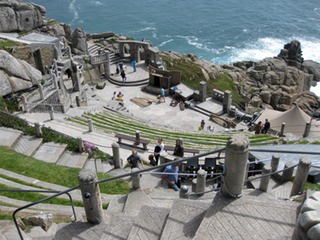
We climbed the cliffs to get to it and later walked back down the narrow road, always on the look out for cars. Since there was nothing else in the vicinity except a cafe and a telegraph museum, we passed the time until the bus came by sitting on the beach below the theatre, watching the surfers.
When we left Sennen Cove campground we asked if they had a place where we could dump our black water (toilet) tank. European motorhomes use a casette system: they remove and empty a small container into a “chemical disposal site,” usually a raised, out-of-the-way sort of sink. But like most or all other American RVers, we need the inground direct-to-sewage-line site. The managers at Sennen Cove did not have that and claimed they had never been asked about it before. (We had asked because it had been four days since we’d last dumped, and while we didn’t urgently need to use it, we don’t want to wait until it’s too late--we’ll leave you to fill in the blanks there.) But at the next campground we actually had a direct sewer access and water right at our pitch--a first for this trip. Twice campgrounds have opened a sewer cover near the bathroom building to accommodate us, and another had a special unit built for requirements like ours.
May 21
Taking a bus instead of driving is definitely easier on us but not on the bus drivers. We took a bus to Penzance, expecting it to travel on the main route. Instead, it rather quickly cut off on a “white” road to a small town. The road brought back a lot of scary memories. We couldn’t believe a bus--a double-decker, no less--would be routed on a one-lane road. But instead of treating it as an error and turning around, the driver kept taking on more challenges, including a 16% grade downhill into Penzance (where we saw not a single pirate, by the way, despite what the souvenir stores would have us believe). From there we changed to another bus for a short trip along the coast to Marazion, where we could walk at low tide to St Michael’s Mount, one more of the National Trust properties--not to be confused with its twin, Mont St Michel, across the channel in France.
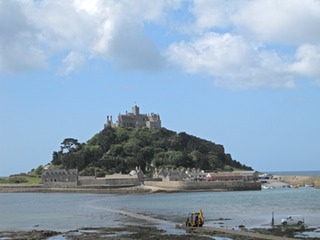
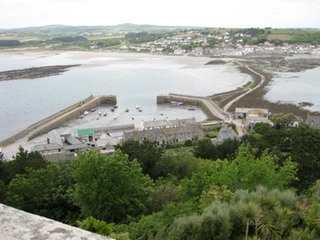
This is fairy tale stuff: At low tide a cobbled causeway is discovered, leading to an island, where a tiny village lies at the foot of a hill, in the shadow of the gloomy castle. Part of the fortress is still lived in, while the rest is open to the public. The grounds are so well kept and beautiful that there is a separate charge for walking through the gardens.
May 19
What a difference a couple of easier days make. We drove out of the Lostwithiel campground on a narrow road and got ourselves safely on a “B” road that brought us to the nearby 600-acre Lanhydrock Estate, now in the capable hands of the National Trust.
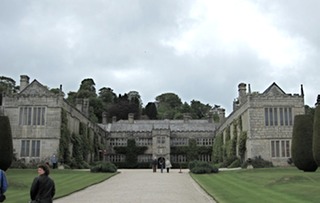
This is another “Gosford Park” setting and has been used as such: Fifty rooms to walk through, each one looking lived in and fabulous, from the servants’ quarters to the grand drawing room. We really felt we should have been in Edwardian dress. The kitchens alone were worth the admission price: a series of half a dozen rooms, each with its own purpose.
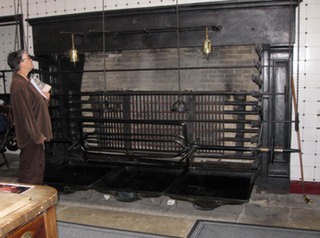
Then it was a simple short drive west to Truro and a visit to a little grocery. We had been concerned about parking in small villages, trying to buy groceries from three or four different places. But it turns out there are “superstores” here as well as on the Continent, where we can almost always park fairly easily. And then there are the “7-11” kind of places that will serve if necessary . . . like the little place near the campground today.
May 17
This is Susan writing. We ended our most recent entry saying (in reference to the driving) that we expected more of the same. But instead it got worse--much worse: damage-to-Rover worse.
We got out of Dawlish reasonably easily, compared to getting in, by heading south and west to a motorway. From there the driving was easy, but with amazing long hills and views. The hills concerned us a little because of our hill/gas problem in Brighton and because our fuel gauge was getting low. But we found gas (at £1.41/litre or $8.32/gal) and went on to the day’s first stop, a National Trust house . . . only to find that it was closed on Mondays. Undaunted, we headed south to the amazing Eden Project, with the GPS taking us in a very roundabout way through a very small town. (Hmm, surely we can do better than that on the way out.)
The Eden Project is a huge piece of engineering and imagination, built since 1997 in an abandoned china clay open pit in Cornwall. It is the quintessential “green” project: educational . . . practical . . . highlighting our dependence on the natural world and encouraging us to care for it. It has several large geo domes made of heavy plastic containing literally thousands of plants from the tropics and all over the world. It attracts thousands of people from all over the world, and no wonder: it was really spectacular and a wonderful way to spend the day.
May 15
When we drove back down the long hill to leave Brighton, we headed for Chichester, stopping on the way at Arundel Castle. This site had great motorhome parking in a large field.
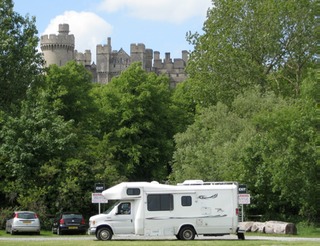
And the castle was impressive, too. It was and is still the home of the Dukes of Norfolk, one of them a friend of Thomas More, another a victim of Elizabeth I. We drove on to Chichester to a sparkling little campground west of the city. In the morning we took a bus toward the town, first stopping at the Roman Palace excavations. We weren’t expecting much but were surprised by the impressive layouts of mosaic floors that hadn’t been uncovered until the l960s. Afterwards we walked into the city, visited the cathedral, and bused back to the campground.
Buses are very expensive. If we weren’t so doubtful about finding parking for Rover in the city centers, it would be cheaper to drive, even with gas at $8 a gallon. We regularly pay $5-6 apiece for a day return ticket. “Pensioners” in England (aged approximately 60+) can ride buses for free, so we see many of them. And since most people at campgrounds are retired, many of them also use the buses regularly.
May 8
May 8
We have seen some remarkable places--the field of the Battle of Hastings in 1066 (at Battle, England, of course), Rudyard Kipling’s home (a gracious large stone house with 13 fireplaces) just as he lived in it, the little town of Rye, the home of Victorian actress Ellen Terry with its collection of threatre costumes and posters--each with lovely English gardens. But to get to these places we have had to drive on English roads, and it isn’t getting any easier. Most of the campgrounds and places we want to visit are off the main roads (and, quite frankly, they, except for the rare divided highway, aren’t much better than the country ones.) Most of them have no shoulder and, in fact, have curbs with hedges right up to the edge of the road. Granted, sharp corners and intersections are well marked (if the hedges haven’t grown over the signs), but speed limits often seem at least 10 mph too high, and we sometimes hear our driver’s side miror hitting hedges on the left. The entrances to the campgrounds have proved to be most exciting: long, single-lane twisting ribbons, lined with trees, with no room for passing . . . hence the rule “leave before noon / arrive after noon.” So far it has worked.
May 2
May 2
(Note: the providers of our website’s ‘comments’ feature announced that our one-year free trial of their service had expired, and they now want $10 a month for us to use it. Because that’s nearly the cost of a beer in Norway, we chose to deactivate the service. However, you can still email us, and we hope you will.)
After a few more days showing Emily our favorite spots in London, we put her on the Underground to Heathrow and returned to Rover late at night, the buses now blessedly running all the way to the campground. The next day we drove to Canterbury, stopping along the way at Leeds Castle at Maidstone. The 500 acres around the castle were impressively gardened, but the castle itself was quite modernized, having been lived in until 1974.
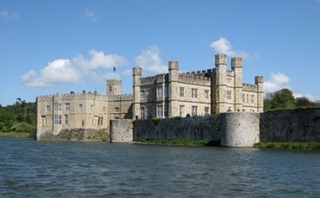
We then drove to Canterbury, skirting just outside the medieval walls and through four traffic circles, one close on to the next, finally arriving at the campground just outside the city.
Like some of the others, this one had gravel pitches (sites) on a large field. It was very spacious. Many people who use caravans (trailers) also put up an awning room attached to the trailer, so the campgrounds often allow quite a bit of space between sites. And again there were no outlets in the bathrooms and a 20p charge for using the hairdryer! This seems to be the scheme in England. Because Susan has a 230-volt European hairdryer, she is unable to use it in Rover. We gave some European camping books to an Australian couple next to us who had rented a van for 6 months and seemed not to have done a lot of planning or research (can you hear our ‘tsk, tsk’?).
April 29.
April 29.
(If, dear reader, you do not care about the Royal Wedding, best skip this post and read the one preceding.)
We are in London for the royal wedding. Our daughter, Emily, flew in to join us. This was our first attempt at having three adult bodies staying in Rover, and on the whole, she and we bore up admirably. (Emily did OK, too.)
On Thursday we scouted the wedding parade route; already there were lots of people camped out to claim space along the barriers on Pall Mall and at Westminter Abbey.
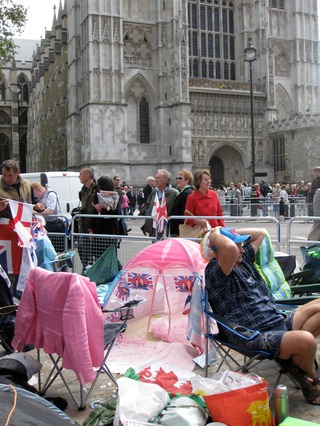
On Friday morning we were up at 5:30 and on our way by 6:30: walk, bus, tube to Charing Cross, and walk down Whitehall toward the Houses of Parliament. By 8 a.m. we had found an incredible spot perched atop a sort of deep, wide, window ledge on the Old War Office Building. We were about 6’ above the sidewalk, just across the street from where the cars would come out of Horse Guards Parade and turn onto Whitehall on their way to Westminster Abbey . . . and where the horse-drawn coaches, flanked by the Horse Guards, would carry the royal party back to the palace after the ceremony.
April 27
We ventured forth into the English countryside. With information from enthusiastic tourist office employees, we drove to Lavenham and Long Melford, two medieval towns that would be great film and tv locations . . . and, as we learned, had been so used. We were told we could get through the narrow streets and that the car parks would accomodate us. Both proved to be true. When we arrived in Lavenham, we parked in a fairly empty lot that, when we returned, had become so full that we immediately moved Rover in order not to be trapped by incoming cars. Then we drove to Long Melford, the last few yards on a street about 12 feet wide. But once again we parked easily in a car park and visited Melford Hall, which looks inside and outside like it could be used for any Jane Austen movie. Susan was charmed. And the weather remained clear and warm.
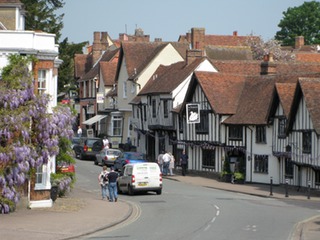
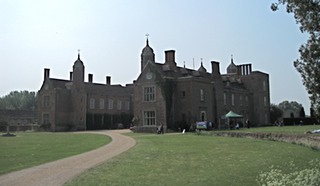
That evening, we ended up on a CL site in Colchester (a CL is “Certified Listing”: a site with 5 or fewer spaces for motorhomes to spend the night). This one was well equipped with water and electricity and even free wifi, a big hit after three days without. We’d read that many CLs offer no extras, just a cheap or free place to park. The friendly and helpful proprietors met us with a cup of tea and the next day gave us a lift into town so we could tour the castle there before moving on. Then we headed to London and our first drive on the M (Motorway).
April 24
(First, our apologies to those of you who have written comments: until we can fix an 'administrator' problem, we won't be able to have comments appear. We can read them...and appreciate them...but nobody else can.)
Because the ferry to England didn’t leave until 10:15 p.m., we decided to spend the day in Den Haag, which is quite close by. But it is a busy city, and all the parking signs led to garages with height restrictions. We finally just lucked out finding a spot on a street alongside a canal. Rover stuck out a little in the rear, but who are we to be judgmental, and we decided to chance it. Besides, it was only about three blocks from where we wanted to go: the library to use the internet briefly, a small museum with a Jan Steen exhibit, and a stroll among some impressive buildings (old ones, naturally).
The narrow road to the Hook of Holland where the ferry loads is full of trucks heading to the freight terminal. We were the first in line to drive on the ferry. All of Susan’s concerns about whether they would take us were for naught: no one asked us anything about our LP gas tank, customs on neither end seemed to care what we had aboard, and British customs didn’t ask for any vehicle emission tests--they just wanted to know if we had a dog.
April 20
On April 12 we left our condo in Minneapolis with three overweight (50+ lb) suitcases. So our first job was to shift books and a 4-lb. box of Borax to our carry-ons. Funny how neither the security guys at Minneapolis nor the ones at Newark airports liked the box of white powder in the carry-on that had all our electronics: phones, GPS, camera, I-Pod, back-up hard drive, each with its own charging station and multiple wires going all over the place. But we probably gave them more excitement than they’d had all day. The Borax was on order from our daughter, now living in Norway, and shifting it and the books gave us 35- and 29-lb. backpacks, which we deftly (!) carried onto our flight to Norway.
After a few days’ visit with our charming granddaughter--
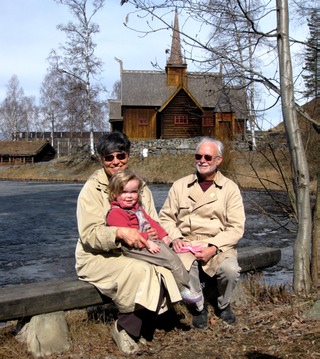
--and her equally charming parents, of course--we flew to Amsterdam with two now-underweight suitcases and picked up Rover. Our new stepdown transformer was waiting for us there (with a sticker that said USPS had first shipped it to Tokyo by mistake). David hooked up the batteries before we left the storage place, and we drove to Gaspaarpark Camping just south of Amsterdam, stopping at a gas station and a grocery store along the way.
